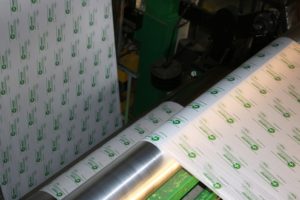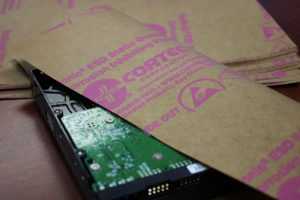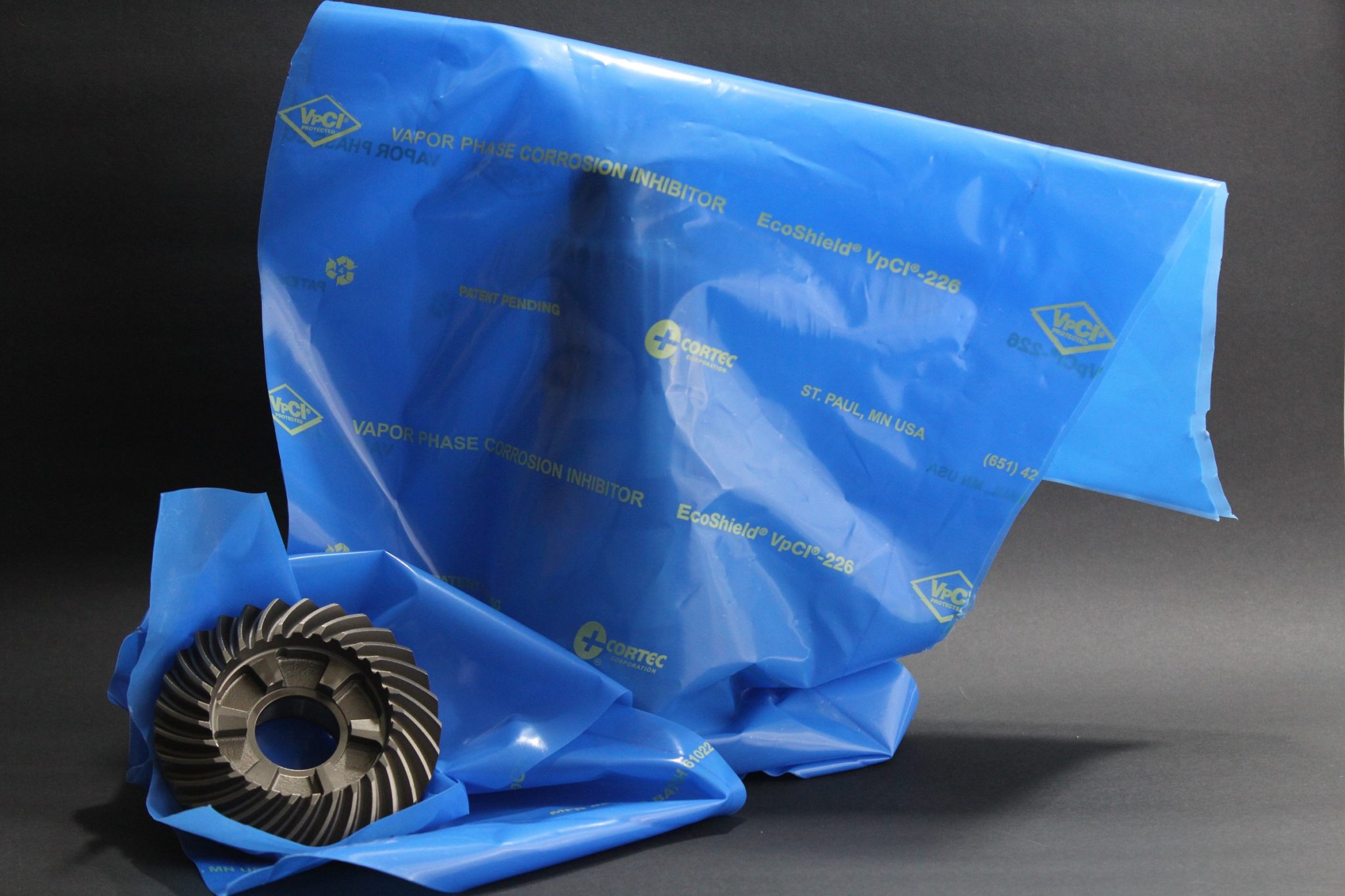Protecting newly manufactured metal parts from rust is a top priority for manufacturers and metalworkers who want customers to receive their goods in excellent condition. This can easily be done by using Cortec® VpCI® papers, films, and boxes, which are enhanced with Vapor phase Corrosion Inhibiting Technology.
Instead of applying greasy rust preventatives that are time consuming and difficult to remove, the manufacturer can simply wrap clean, dry, freshly machined parts in a sheet of VpCI® paper or film, or place them in VpCI® boxes. When the parts arrive at their destination, they can be taken out of the packaging corrosion-free and ready to use.

Countering Common Corrosion Threats
While oxygen alone threatens to degrade newly machined metals with flash rust, adding moisture into the equation increases the risk of corrosion. During storage or shipping, moisture can come from high humidity environments, or from extreme changes in temperature which create condensation on the metal surfaces.
VpCI® packaging helps protect against both of these dangers because Vapor phase Corrosion Inhibitor molecules in the packaging evaporate and condense in an invisible protective layer on metal surfaces enclosed within the package. This molecular barrier keeps the metal from interacting with oxygen and moisture and starting the corrosion process. When the metal part is taken out of the packaging, VpCI® molecules naturally start to leave the surface, so no extra step is needed to remove the protective layer before using the part. The used VpCI® film and paper can typically be recycled.
Surviving Extreme Humidity Testing
The corrosion protection ability of VpCI® packaging was demonstrated by the excellent performance of a VpCI® packaging system tested in extreme humidity chamber conditions according to ASTM D-1735. This standard test exposes test specimens to an environment of approximately 100% relative humidity at a temperature of 38 °C (100.4 °F). This environment is so moisture ridden that unprotected metal pieces easily corrode within 24 hours or less.
When Cortec® Laboratories subjected a variety of sintered metal gears, locking plates, and pinions to ASTM D-1735 humidity testing at its IEC 17025 accredited lab, it saw a marked difference between parts packaged in VpCI® and those that were unprotected. Unprotected control specimens experienced moderate to heavy corrosion in only 15 hours of testing. Parts wrapped in a packaging system of VpCI®-146 paper inside VpCI®-126 bags still had no corrosion after 427 hours of accelerated humidity testing.
Since this test greatly exaggerates the typical humidity level present during metal storage or shipping and effectively saturates the environment with a continuous water fog, the protection of VpCI® film and paper can be expected to be far greater under normal manufacturing, warehouse, and shipping conditions. In real life conditions, a single sheet of VpCI®-146 paper is often all that is needed to add an extra layer of corrosion protection to, for example, an automotive part being shipped to a customer.
Longer-term or overseas export conditions may warrant additional layers of protection, as when both VpCI® paper and film were used in the ASTM D-1735 humidity test. A dry film rust preventative like BioCorr® (a USDA Certified Biobased Product that easily rinses off with water) can also be applied as needed.

Taking into Account Special Concerns
Depending on the product being protected and the shipping or storage conditions expected, specialized VpCI® paper and film variations are available to address specific concerns.
• Electronics can be protected from both corrosion and electrostatic discharge by using Cortec’s Ecosonic® ESD paper or VpCI®-125 static dissipative film.
• Oddly shaped or sharp objects such as steel coils, plate, and bars can be protected with CorShield® VpCI®-146 Reinforced Paper.
• For situations where elevated moisture levels are likely, a high gloss Super Barrier version of EcoShield® VpCI®-144 reduces the paper’s water vapor transfer rate but allows it to retain its recyclability, making it a more environmentally friendly alternative to polycoated and wax paper while providing corrosion protection.
• The oil and grease resistance of VpCI®-148 paper plays a dynamic role in protecting metals that retain process oil during shipping. In one situation, process oils broke down a corrosion inhibiting polyethylene film being used to protect automobile frames, allowing tarnish and corrosion spots to form. The use of VpCI®-148 paper solved this problem and kept the frames protected.
• For small parts that will be individually packaged, VpCI® CorrTainer® boxes offer the convenience of slipping a metal part directly into the VpCI® box and closing it. The metal parts will be protected during shipping and can simply remain in the box for further protection if temporarily placed on the storage shelf.
Whatever the level of protection needed, an excellent packaging system can be tailored to the manufacturer’s storage and shipping needs by drawing from a variety of VpCI® papers, films, boxes, and related packaging materials. These protective options are not only effective, but are also very easy to use and dispose of when needed.
Whatever the level of protection needed, an excellent packaging system can be tailored to the manufacturer’s storage and shipping needs by drawing from a variety of VpCI® papers, films, boxes, and related packaging materials. These protective options are not only effective, but are also very easy to use and dispose of when needed.
For more information about Cortec® Packaging Solutions, please visit:
http://www.cortecpackaging.com/
For more information about Cortec® Coated Products, please visit:
http://www.corteccoatedproducts.com/
For more information about Cortec® Advanced Films, please visit:










